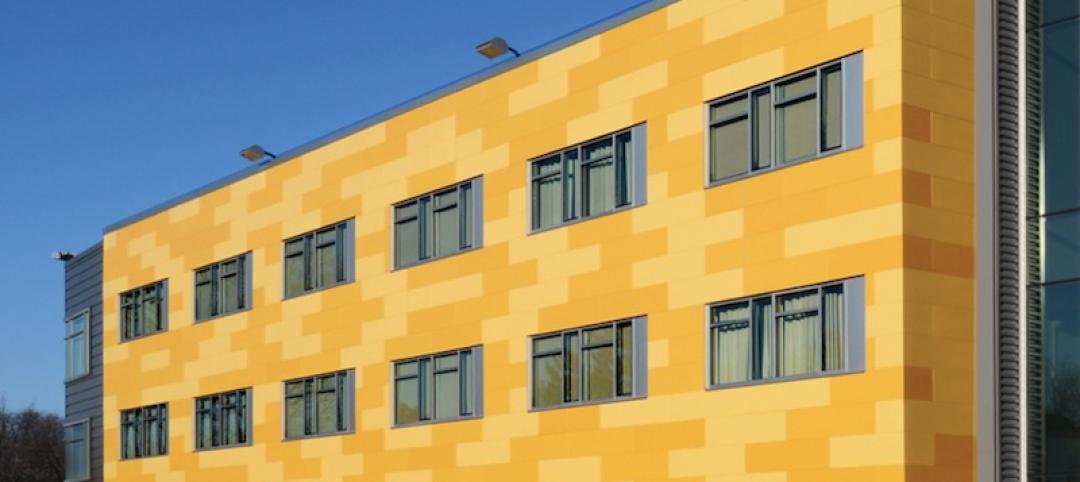At 35 stories, the State Courts Towers at Havelock Square is the tallest government building in Singapore. And while it’s been open since December 2019—when the State Courts started relocating from a nine-story building that dated back to 1975—details and images about its design and construction have only recently been made public by CPG Consultants, the S$450 million (US$334.6 million) project’s Principal Consultant and Architect.
The 178-meter (584-ft) building contains 53 courtrooms and 54 hearing chambers. The structure, designed by Serie + Multiply Consultants, is actually two slender buildings, the Court Tower and Office Tower, connected by 39 link bridges. The design optimizes visibility to the public, with courtroom boxes placed onto large “court trays” of different heights and sizes that are completely open in that there is no glazed façade around the tower.
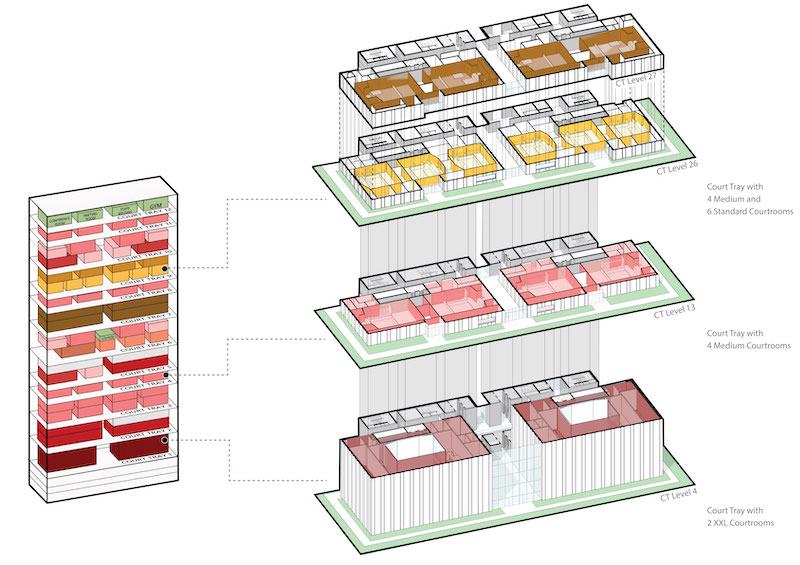
The towers' 53 courtrooms are placed onto “trays” of different sizes that are “open,” in that there's no glazed facade. Illustration: CPG Consultants
Each “tray” includes a garden terrace that filters sunlight and allows for views of the city. The courtrooms themselves are clad in pigmented precast panels, five to 12 meters in height, whose colors and textures match the tiled roofs of shophouses in Singapore’s nearby Chinatown.
“The relationship between the city and its civic buildings was our primary interest for this project,” explains Christopher Lee, Principal at Serie Architects UK. “The new State Courts Towers should be a building that is symbolically open and accessible to the public. Its design language is drawn from the architecture typical of the city and hence is both familiar and surprisingly new to its citizens.”
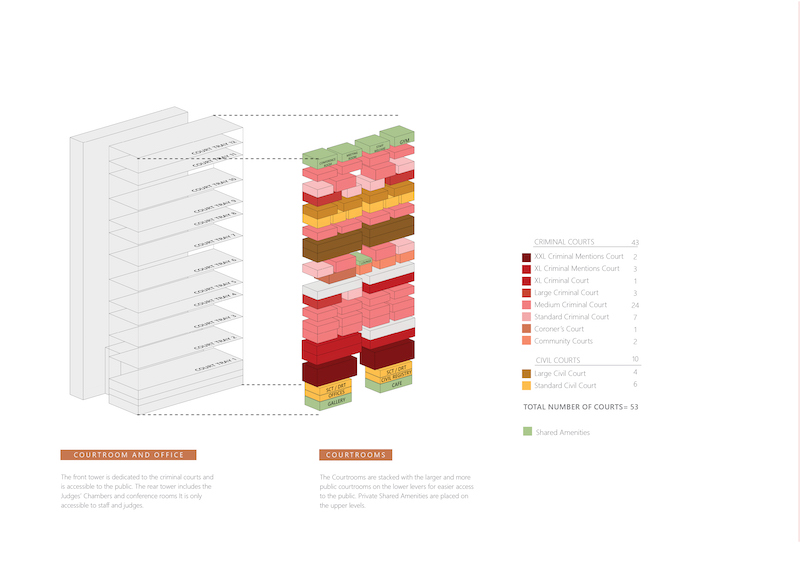
The front tower includes the courtrooms and is accessible to the public; the back tower is for judges' chambers and conference rooms. The towers are linked by 39 bridges. lIlustration: CPG Consultants; Image: Khoogj
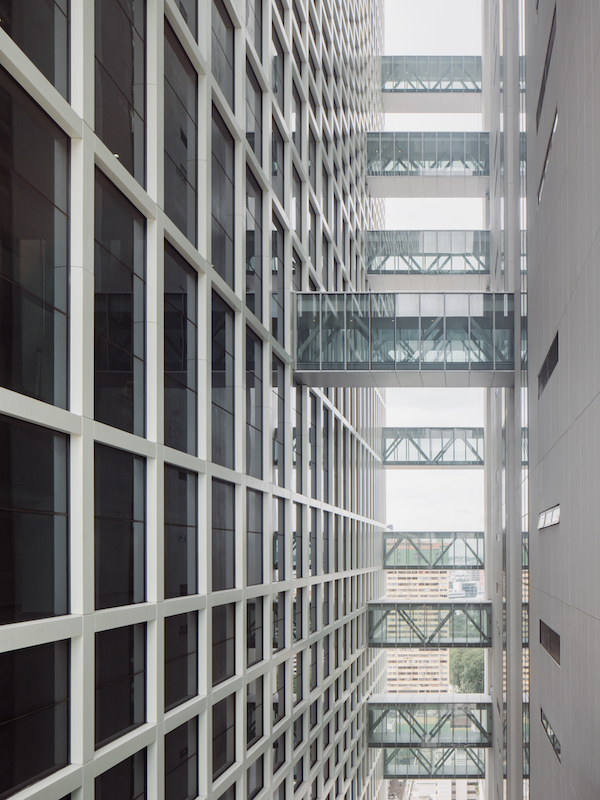
A SMART, TRANSPARENT BUILDING
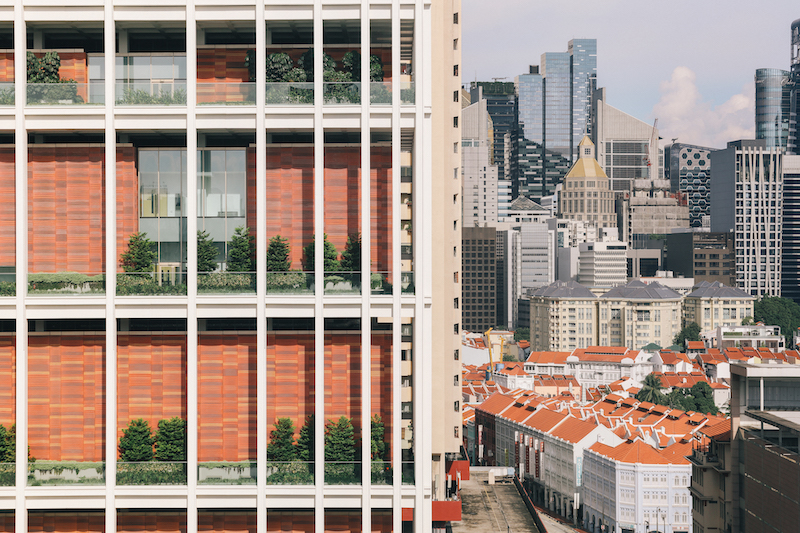
The cladding for the courtrooms is precast panels, 5 to 12 ft in height, whose colors and textures match to roofs of nearby shops in Singapore's Chinatown. Image" Finbarr Fallon
The office tower, for judges’ chambers and staff offices, features a vertical façade that expands where light and views are required in the middle, and contracts where the service core is located. Horizontal grids draw the viewer’s eye across the façade and to the sky.
The towers include a coworking space managed by the Singapore Academy of Law, for attorneys and tech companies; a theatrette, business center, cafeteria, roof garden and sky terraces, and a library and auditorium located in the basement.
The complex’s smart building features include facial recognition and automated building management processes for security and MEP systems. Other IT or web-enabled services introduced include video-conferencing facilities and interactive self-service kiosks. A universal design approach was adopted to ensure that it is user-friendly to the judges, persons in custody, and the public, for example in providing Assistive Listening Systems for court attendees and in all its courtrooms, digital wayfinding through apps.
The State Courts Towers is an environmentally sustainable building, with green building features incorporated in its design, such as solar panels and condensate water recovery systems.

Open space, acoustics, user inclusion, visibility, and smart technology were important factors in the design of the courtrooms. Illustration: CPG Consultants; Image: Khoogj

Related Stories
Sponsored | | Sep 23, 2013
Nichiha USA panels provide cost savings for community project
When tasked with the design and development of a newly constructed Gateway Rehabilitation Center, architects at Rothschild Doyno Collaborative first designed the new center to include metal panels. When the numbers came back, they were challenged with finding a product that would help cut costs and keep them within the construction budget. Nichiha’s fiber cement panels come in a half or less of the metal panel cost.
| Sep 19, 2013
What we can learn from the world’s greenest buildings
Renowned green building author, Jerry Yudelson, offers five valuable lessons for designers, contractors, and building owners, based on a study of 55 high-performance projects from around the world.
| Sep 19, 2013
6 emerging energy-management glazing technologies
Phase-change materials, electrochromic glass, and building-integrated PVs are among the breakthrough glazing technologies that are taking energy performance to a new level.
| Sep 19, 2013
Roof renovation tips: Making the choice between overlayment and tear-off
When embarking upon a roofing renovation project, one of the first decisions for the Building Team is whether to tear off and replace the existing roof or to overlay the new roof right on top of the old one. Roofing experts offer guidance on making this assessment.
| Sep 17, 2013
Complex stained glass restoration under way on Wisconsin Capitol Building
Work is under way at the Wisconsin State Capitol on an extensive $2.7 million, 14-month renovation to the skylights above the House and Senate chambers, along with the barrel vault skyline above the grand staircase and the panels in the rotunda dome.
| Sep 16, 2013
Study analyzes effectiveness of reflective ceilings
Engineers at Brinjac quantify the illuminance and energy consumption levels achieved by increasing the ceiling’s light reflectance.
| Sep 11, 2013
BUILDINGChicago eShow Daily – Day 3 coverage
Day 3 coverage of the BUILDINGChicago/Greening the Heartland conference and expo, taking place this week at the Holiday Inn Chicago Mart Plaza.
| Sep 10, 2013
The new medical office building: 7 things to know about today’s outpatient clinic
Regulatory pressures, economic constraints, and emerging technologies are transforming healthcare. Learn how Building Teams are responding with efficient, appealing, boundary-blurring outpatient buildings.
| Sep 10, 2013
BUILDINGChicago eShow Daily – Day 2 coverage
The BD+C editorial team brings you this real-time coverage of day 2 of the BUILDINGChicago/Greening the Heartland conference and expo taking place this week at the Holiday Inn Chicago Mart Plaza.
| Sep 4, 2013
Smart building technology: Talking results at the BUILDINGChicago/ Greening the Heartland show
Recent advancements in technology are allowing owners to connect with facilities as never before, leveraging existing automation systems to achieve cost-effective energy improvements. This BUILDINGChicago presentation will feature Procter & Gamble’s smart building management program.



